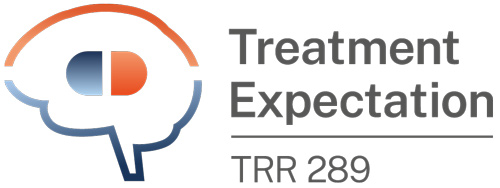Functional MRI showing brain activity during perception of pain.
© SFB Treatment Expectation
Functional MRI showing brain activity during perception of pain.
© SFB Treatment Expectation
How do expectations change – and what influence do they have on pain and the treatment of pain?
Thoughts, experiences, and expectations can strengthen or weaken our experience of pain, and strongly influence how well pain treatment will work for an individual person. But what are the psychological and neuronal mechanisms underlying this effect? How, and for what reasons, do people’s expectations change? And what consequences does this have for the success of individual pain treatment? To find some answers to these questions, in Project A01, we use functional magnetic resonance imaging (fMRI) to visualize study participants’ brain activity.
Negative expectations impact pain more strongly than positive expectations
In the first funding period of our Collaborative Research Centre, we have gained significant knowledge about how positive and negative expectations develop, how they are maintained, and how they change over time. The results so far suggest that negative expectations have stronger, and longer-lasting, effects on our experience of pain than positive expectations.
Another large controlled pharmacological trial showed that the dopaminergic system, with the neurotransmitter dopamine, is a key factor in the pain-inhibiting impact of placebo effects. And finally, we were able to identify certain brain regions whose interaction plays a role in the development of nocebo effects.
Focus on back pain, the noradrenergic system, and the ability to change expectations
In the second funding period, we would like to deepen this knowledge in Project A01 and extend it to investigations in patients with chronic back pain. In particular, we also want to look at the role of the noradrenergic system in changing expectations. The neurotransmitter noradrenaline is involved in the nervous system in the brain, and impacts, among other things, our emotions, sleep, attention, and learning processes. Additionally, we will focus on the dynamics and changes of expectations over time. For example, we will follow patients who are undergoing multimodal pain therapy over a longer period of time.
Bingel U, Wanigasekera V, Wiech K, Mhuircheartaigh R, Lee MC, Ploner M, Tracey I (2011) The effect of treatment expectation on drug efficacy: imaging the analgesic benefit of the opioid remifentanil. Science Transl Med 70. 70ra14. PubMed
Wrobel N, Wiech K, Forkmann K, Ritter C, Bingel U (2014) Haloperidol blocks dorsal striatum activity but not analgesia in a placebo paradigm. Cortex 57: 60-73. PubMed
Zunhammer M, Ploner M, Engelbrecht C, Bock J, Kessner SS, Bingel U (2017) The effects of treatment failure generalize across different routes of drug administration. Sci Transl Med 9(393) pii: eaal2999. PubMed
Zunhammer M, Bingel U, Wager TD; Placebo Imaging Consortium (2018) Placebo effects on the neurologic pain signature: A meta-analysis of individual participant functional magnetic resonance imaging data. JAMA Neurol 75(11):1321-1330. PubMed
In close cooperation with these projects
How we create our own expectations – and the role that attention plays in this
Prof. Dr. Christian Büchel
How expectations influence stomach ache – and how the experience of pain changes treatment expectations
Prof. Dr. Sigrid Elsenbruch
PD Dr. Julian Kleine-Borgmann
How do expectations control our emotions - and what does attention have to do with it?
Prof. Dr. Stefanie Brassen
How can expectation effects help to reduce pain after a hip operation?
PD Dr. Regine Klinger
Prof. Dr. Sigrid Elsenbruch
What role does the cerebellum play in placebo and nocebo effects?
Prof. Dr. Dagmar Timmann
How are other people doing – and what does that mean for me?
PD Dr. Jan Haaker
Prof. Dr. Christiane Melzig
Warmth, competence and more: What practitioners can achieve through communication
Prof. Dr. Helen Blank
Prof. Dr. Katja Wiech
Project Lead

Prof. Dr. Ulrike Bingel
Neurologist, Neuroscientist
Team
Dr. Katharina Schmidt
Postdoc, Psychologist, Neuroscientist
Dr. Helena Hartmann
Postdoc, Psychologist, Neuroscientist
Dr. Belkis Ezgi Arikan
Postdoc, Psychologist, Neuroscientist
Dr. Livia Asan
Clinician Scientist, Resident in Neurology
Rebecca Lutz
PhD student
Vivien Janowicz
PhD student
Aoibhne Braunewell, Sam Völk, Hannah Gronewold
Medical students




